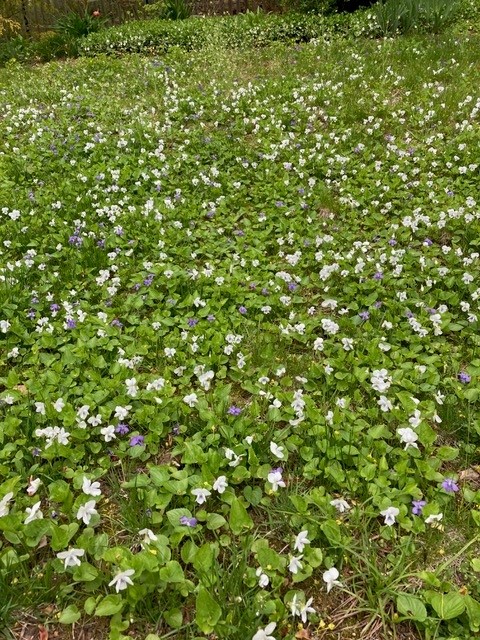I had never heard of No Mow May until last year, and I felt like I had failed my readers by falling behind the times. It turns out I wasn’t far behind.
No Mow May was initiated in England in 2019 and made it to the United States, originally in Wisconsin, in 2020. It showed up everywhere here about the time I heard about it.
But even though I had never heard of the movement, it turns out I had been following its principles for more than a decade. Our lawn area – which never gets pesticides, rarely gets fertilizer and is probably made up of less than half grass – doesn’t need mowing before June. Last year, it required mowing a total of four times, and I use a small electric mower, which is much less polluting (and noisy) than the gas-powered kind.
The idea behind No Mow May is to let flowering plants that many people consider weeds – dandelions, clover, violets and others – blossom over several weeks early in the season, providing food for bees, butterflies, moths and other insects. This isn’t merely a nice thing to do for your fellow creatures; without pollinators like bees, humans would have a hard time finding enough to eat. Pollinators need your help. They face a multitude of threats, among them pesticides, and habitat loss and fragmentation.
The timing is perfect for northern states because most homeowners don’t begin to mow until May anyway, and many of the flowering weeds have finished blooming by the end of the month. Some groups farther south have been suggesting a No Mow March as an alternative.
No Mow May was a frequent subject of discussion early last June when the Maine Audubon Society held its annual Native Plants Festival and Sale, which includes lectures and panel discussions. I took notes, knowing I’d want to write a column on the topic. (Mark your calendar. The Audubon event will be June 17 this year).
Speakers agreed that if a lawn has been regularly treated with weed-and-feed fertilizer, there’s little benefit to avoiding mowing. Weed-free lawns have no flowers, hence can’t help pollinators (yet another reason to steer clear of weed killers, especially on lawns). I suppose if owners of lawns like these don’t mow in May, at least they’re not burning fossil fuels and polluting the air, as many lawn mowers do.
People who tend municipal parks and other public spaces apparently love No Mow May – and not for the reason you’d think. Many municipalities are struggling to hire workers for their grounds crew. They’re short on staff to mow public lawns. Public works directors are, apparently, perfectly happy if people think the lawns are growing tall because towns are taking part in No Mow May.
Unlike folks who’ve got perfect green lawns, our property is ideal for keeping our mower stored away until after May. Our back lawn is dominated by violets, both blue and white, which are different species in the same family. Both are short-lived perennials native to Maine, much of the Eastern United States and Southeastern Canada. They self-seed easily. The blue violet, Viola sororia, is vital to the reproduction of fritillary butterflies, according to the Xerces Society.
As Monarch butterflies rely on milkweed, 14 species of greater fritillaries (Speyeria) and 16 species of lesser fritillaries (Bolloria) lay their eggs only on violets, which provide the only food their larvae can eat. The butterflies and the plants need each other. In addition, according to the Xerces Society, the native mining bee, Andrena violae, visits only violets. Wild habitat for bees is shrinking because of development; do your bit to help them by encouraging violets.
Plus, it’s pretty to see the lawn dotted with white and purple violets. In fact, we like violets so much that my wife, Nancy, has on order from Avant Gardens another violet, Viola odorata or “Irish Elegance”; it’s a cultivar, though, and not native to America.
Our May lawn includes other flowering plants that many people consider weeds, such as dandelions. Dandelions are native to Eurasia, possibly brought to America for medicinal use by pilgrims on the Mayflower. In years past, I carried a Hori Hori knife as I walked through our yard and would dig out dandelions. I’ve given up that practice. Now, I let the dandelions grow, recalling my childhood practice of blowing the dandelion seeds after they have developed. Also, you can eat the young greens (if you aren’t using pesticide on your lawn). When I was a kid growing up in Farmington, my grandfather used to cook them.
Clover also benefits from No Mow May. When my parents built their home in the 1950s, my father asked the seed company to include clover in the lawn-seed mix. Clover provides nitrogen to the lawn grass, making the lawn healthier. Happily, it’s making a comeback in lawn mixes. Clover also blossoms in early spring, well before June 1, providing food for pollinators.
While we’re on the subject, think about shrinking your lawn. The kind of uniform, green lawns beloved by so many Americans require a lot of water, a lot of pesticides and fertilizers, and typically a lot of gas to mow them.
It’s good to have so many reasons to avoid mowing.
Tom Atwell is a freelance writer gardening in Cape Elizabeth. He can be contacted at: tomatwell@me.com.
Send questions/comments to the editors.


